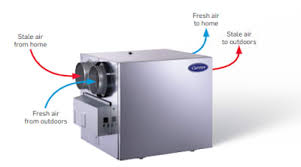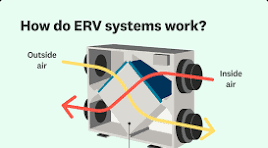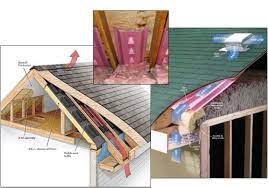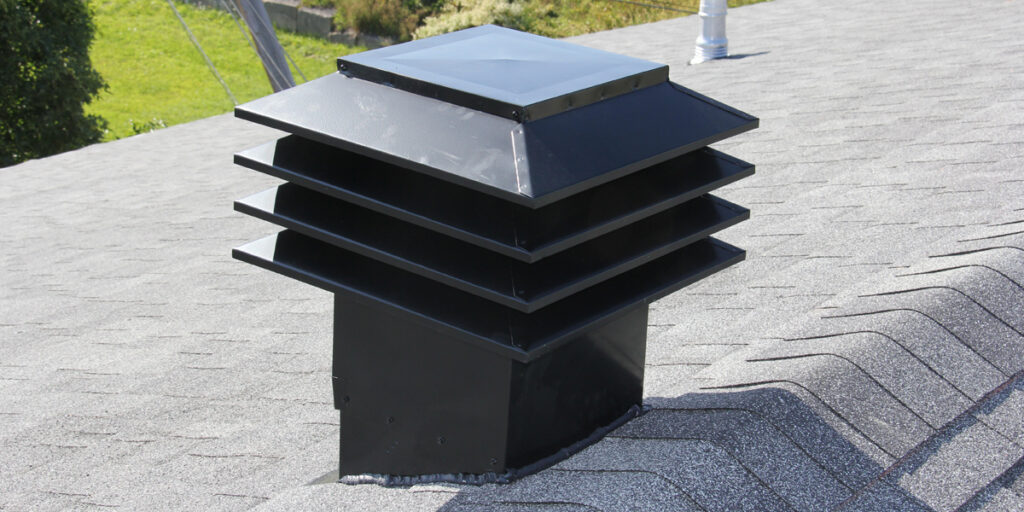
Written by: Alex Gray, President Sightline Building Solution
Ventilation and Indoor Air Quality
Part 3 of our 12-part series on Northern and Remote Housing
In our last blog, we discussed foundations and site preparation—critical steps in ensuring the stability and longevity of homes in the North. Now, we turn our attention to another essential aspect of northern housing: ventilation and indoor air quality.
Due to extreme temperatures, northern homes are built to be highly airtight, which significantly improves energy efficiency but can lead to issues with indoor air quality if proper ventilation is not maintained. Without adequate ventilation, homes can experience moisture buildup, poor air circulation, and increased health risks for occupants.
The Importance of Proper Ventilation in the North
1. Managing Moisture and Preventing Mold
One of the biggest challenges in northern housing is managing moisture. Because homes remain sealed for most of the year due to cold temperatures, moisture from daily activities—cooking, bathing, and even breathing—can accumulate. If this moisture isn’t properly vented, it can lead to condensation, which encourages mold growth and compromises structural integrity.
Key strategies for moisture control:
- Mechanical Ventilation: Homes are required to have mechanical ventilation such as Energy Recover Ventilators (ERV) and Heat Recovery Ventilators (HRV). These units pre-heat the fresh incoming air into your home, reducing the amount of energy required by the heating system to maintain the desired indoor temperature, improving the energy efficiency of the homes HVAC (heating, ventilation, air conditioning) system. The main difference between the two are ERV’s pre-heat incoming air and achieves optimal indoor humidity levels, while HRV’s only pre-heats fresh incoming air and removes moisture from the home all together.
- It is vital that bathroom and kitchen exhaust fans are turned on while in the shower or cooking. For instance, there is a huge amount of moisture created in the home when the shower is turned on. If the humid air is not removed from the bathroom, then there will be excessive condensation forming on the windows and the moisture will be absorbed into the walls, ceiling, cabinets and floor. When showering next, check to see how foggy the mirror is. If you can’t see yourself, the bathroom fan is not on or working properly and needs to be corrected. In addition, when cooking moisture is released into the air when the occupant boils water or cooks’ food. Turning on the kitchen exhaust fan on will remove the moisture and any smells.
- Proper Air Sealing: Preventing air leaks while allowing controlled ventilation to manage humidity levels. For a ventilation system to properly maintain the home’s humidity levels, it’s important to ensure the outdoor air remains outside and the warm conditioned indoor air stays inside, while relying on the mechanical ventilation system to keep the indoor air fresh.
- Adequate Insulation: Well-insulated walls reduce the likelihood of cold spots where condensation can form. Insulation keeps the cold air outside by creating a thermal barrier. If there are voids in the barrier, the cold outdoor air will get into the wall and meet the warm indoor air, creating condensation to form inside the wall, which will turn into mold and the structure will begin to rot.


2. Ensuring a Healthy Indoor Air Supply
Without fresh air circulation, indoor air can become stagnant and filled with pollutants, including carbon dioxide, volatile organic compounds (VOCs), and radon gas. Proper ventilation ensures a steady exchange of fresh outdoor air and the removal of stale, contaminated air.
To improve indoor air quality:
- Install Air Exchangers (HRVs or ERVs): These systems bring in fresh air while recovering heat from outgoing stale air, reducing energy demand.
- Use High-Quality Air Filters: Regularly changing filters in HVAC systems helps remove airborne pollutants. The frequency of the filter’s replacement is base on the type of filter and the furnace/air handler. Ask your property manager how often your filter should be replaced.
- Incorporate Natural Ventilation: When weather permits, opening windows can supplement mechanical systems by allowing fresh air inside. It’s always nice to feel the breeze on a warm summer’s day.
3. Preventing Heat Loss While Ventilating
In northern climates, opening windows for ventilation is not always practical due to extreme cold. Heat recovery ventilators (HRVs) and energy recovery ventilators (ERVs) are effective solutions that provide continuous ventilation while minimizing heat loss.
HRV vs. ERV: Which One is Best for Northern Homes?
In Northern Ontario, an Energy Recovery Ventilator (ERV) is generally preferred over a Heat Recovery Ventilator (HRV). While both systems recover energy, ERVs are better suited for Northern Ontario’s climate because they control both heat and moisture, which is crucial for managing humidity in cold, dry winters and hot, humid summers.
Moisture Control:
ERVs can transfer moisture between incoming and outgoing air, helping to regulate indoor humidity levels. In Northern Ontario’s cold, dry winters, this can prevent indoor air from becoming too dry and uncomfortable, while in the summer, it can help manage humidity, reducing the load on air conditioning.
Year-Round Comfort:
ERVs can help maintain comfortable indoor air conditions year-round, addressing both the dry winter air and the humid summer air
Reduced Energy Consumption:
By controlling both heat and humidity, ERVs can help reduce the amount of work your heating and cooling systems need to do, leading to energy savings
Winter Considerations:
In the winter, ERVs can recover moisture that would otherwise be lost, helping to maintain a comfortable humidity level and prevent static electricity and other issues associated with dry air
While HRVs are good at recovering heat, they don’t have the moisture-controlling capabilities of ERVs, which is why they are often not as well-suited for the diverse climate conditions of Northern Ontario.
Designing Effective Ventilation Systems
1. Balanced Ventilation for Uniform Airflow
A well-designed ventilation system ensures air is evenly distributed and managed throughout the home. A balanced ventilation system combines intake and exhaust fans to create consistent air pressure, preventing drafts or negative air pressure that can pull in pollutants from outside.
Best practices for balanced ventilation:
- Supply Air to Living Spaces: Deliver fresh air to bedrooms and living rooms.
- Exhaust Air from Wet Areas: Remove stale air from kitchens, bathrooms, and laundry rooms where moisture buildup is common. Exhaust vents should be exhaust through the side wall, not the attic. In the winter, if exhaust ducting is run through the attic, the warm air will meet the cold air in the attic and create condensation inside the ducting, resulting in condensate (water) dripping out from the fan vent cover.
- Use a Centralized ERV System: Connecting ventilation ducts throughout, and are exhausted properly outside the home ensures efficient airflow.
2. Spot Ventilation for High-Humidity Areas
Certain areas of the home require additional ventilation to prevent moisture accumulation.
- Bathroom Exhaust Fans: Essential for removing humidity after showers.
- Kitchen Range Hoods: Capture steam and cooking fumes to prevent condensation.
- Laundry Room Venting: Prevents excess moisture from accumulating inside the home.
3. Preventing Ice and Frost Buildup
A poorly designed ventilation system can cause ice buildup in attics and walls due to trapped moisture. Proper attic ventilation prevents condensation from forming and reduces the risk of structural damage.
Ways to prevent ice buildup:
- Install Soffit and Attic Ventilation : These allow continuous airflow through the attic space. It’s very important that there is a clear path for air to flow from the soffit to the vents at the top of the roof. This is achieved by using baffles where the ceiling meets the roof at the corner of the building. Attic’s have gable vents that are commonly found on the wall at the peak of the roof.
- Ensure Proper Insulation: A well-insulated attic prevents warm air from reaching cold surfaces. It’s very important that there is a clear air flow from the soffit to the roof top vents. This is achieved using baffles.
- Use Vapor Barriers: These reduce moisture migration into walls and ceilings.


Energy-Efficient Ventilation Strategies
Since heating costs are a major concern in northern communities, ventilation must be designed to minimize energy loss while maintaining air quality.
- Use Smart Ventilation Controls: Some HRVs and ERVs come with humidity sensors that automatically adjust ventilation rates.
- Seal Ducts Properly: Leaky ducts reduce efficiency and increase energy costs.
- Consider Passive Ventilation: In milder seasons, strategically placed vents and windows can supplement mechanical systems.
Final Thoughts
Effective ventilation is critical for maintaining a healthy, energy-efficient, and resilient home in the North. By incorporating balanced ventilation systems, preventing moisture buildup, and maximizing heat recovery, northern homes can ensure long-term comfort and durability.
In the next installment of our 12-part blog series on building in the North, we’ll explore reliable heating systems that provide comfort and reduce the home’s operating costs. Stay tuned for more insights on constructing durable, efficient, and long-lasting homes in remote northern communities.
May 28, 2025
